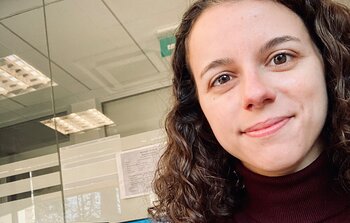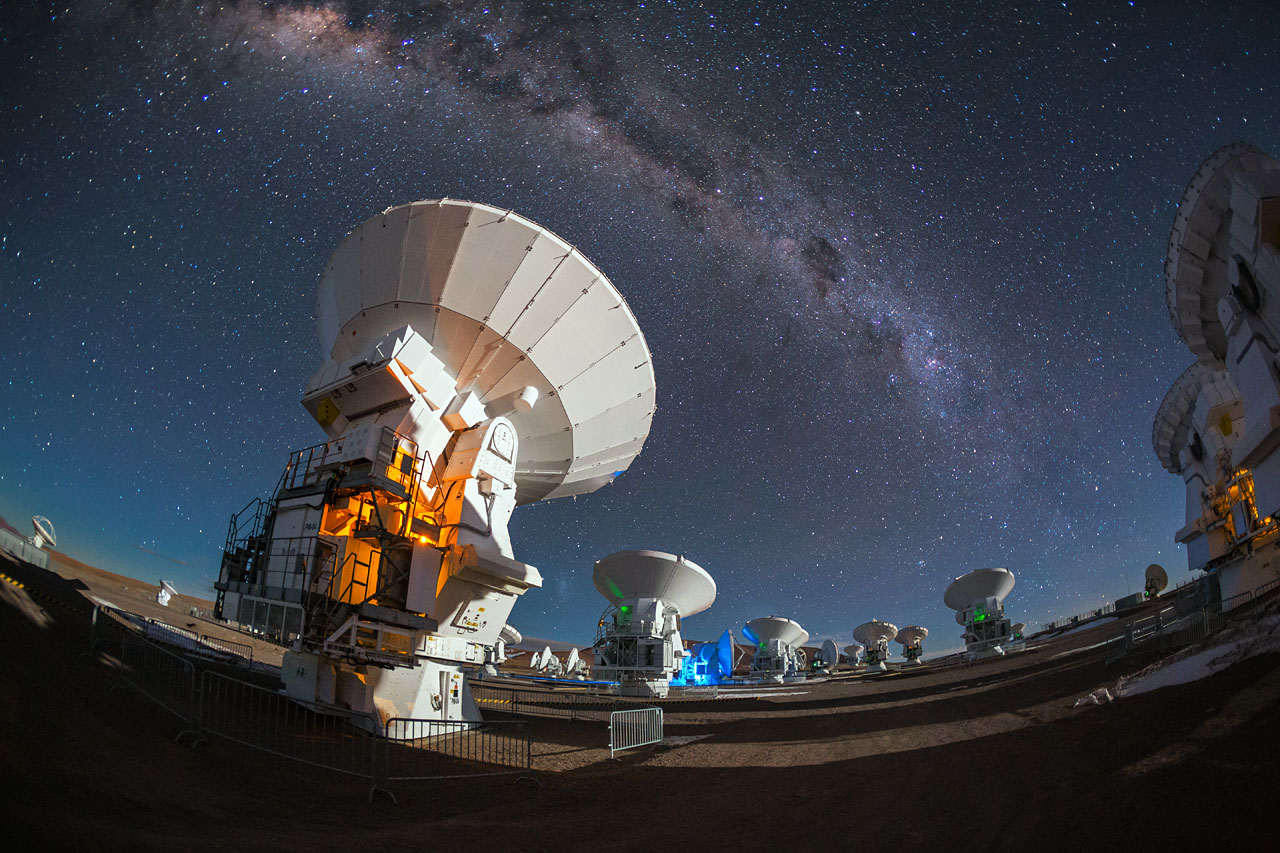- Why not all astronomers are nocturnal creatures
- How it’s like to observe remotely with ALMA
- The challenges of working on-site in the Atacama Desert
ALMA, the Atacama Large Millimeter/submillimeter Array, is an ensemble of 66 antennas that observe the cold dark universe from the remote Chajnantor Plateau in the Chilean Atacama Desert. The antennas work together as a single kilometre-sized telescope, giving us unique insights on all sorts of cosmic objects, from planet nurseries to the very first galaxies. But how is it like to operate such a complex machine? Marie-Lou Gendron-Marsolais, an ESO Fellow in Chile, has given us an exclusive behind-the-scenes look at a day in the life of an ALMA astronomer.
It is 6:30 am and the crisp cold air would wake up even the most sleepy astronomer. On the short walk from my home to the ALMA office along the deserted streets of Santiago, the sky is still completely dark and I look up to see if some bright stars are piercing the light pollution of the megalopolis. The moon is accompanied by Jupiter and Saturn, offering a surprisingly harmonious spectacle that makes me smile.
Most people think that astronomy is a science exclusively done by night, but it is not the case for many telescopes. It all depends on the light you are looking for! There is much more light than just the colours of the rainbow and, with specific types of telescope, this “invisible light” is accessible. In the case of ALMA, we collect “radio” light. Since the Sun does not emit much radio light and our atmosphere does not diffuse it, the radio sky is not too bright during the day and we can observe with ALMA any time of the day. Therefore, astronomers are not necessarily night creatures…
The global pandemic situation has hit ALMA operations hard, forcing us to completely shut down the site for many months. Since then, the devoted work of technicians and engineers has allowed us to restart nearly all of our cherished antennas and start observing again, a daunting task! The observatory is located 1200 km north of Santiago. To reduce the amount of travelling and the number of people on site, we, astronomers, are now observing mostly from Santiago, in our new remote control room.

At the ALMA headquarters, I am welcomed by Jose Miguel, Data Analyst, who has spent the whole night observing. “Perfect weather up there!”, he says, before discussing with me some additional technical details on the work accomplished and the state of the telescope. I wish him a good “descanso” as this is his last night and a new team is taking over today.
After the disinfection of the control room, I take seat in the familiar decor, greeted through videoconference by Hector, Array Operator Deputy Manager, in the room across the corridor, and Ludwig, Array Operator, at the Operations Support Facility up in the desert, just 30 km away from the antennas themselves.
Despite the fatigue and the fact that I haven’t stepped foot in this room for several weeks, my eyes sweep across the four control screens full of different tools, plots and scrolling terminals, and almost instantaneously everything comes back. It is a bit like riding a bike — you just never forget how to do it! But perhaps it has to do with the fact that I have spent more than 600 hours here in the last 2 and a half years! And still, each time, I learn new things. ALMA is a very complex machine.
Ludwig, who’s in charge of keeping the antennas in good condition, guides me through the plan of the day as he will leave the site in a couple of hours after a complicated shift. I know very well from experience that living more than a week at 3000 metres above sea level in the harsh weather of the Atacama Desert is far from relaxing. Last night, the temperature dropped to -15 ºC, and in the last 2 weeks ALMA has been hit by severe snowstorms and high winds. It took days for the team to clear the snow and recover the telescopes…
But the weather now is incredible. Our weather stations constantly measure the amount of water vapour above the antennas, which is currently exceptionally low. The extreme dryness of the air is what makes the Chajnantor plateau ideal for radio astronomy — it is absolutely essential since water in the atmosphere will absorb the light we are trying to collect. I wish Ludwig a safe trip home.
Today, the engineers have not requested to work on the antennas, so we have the go ahead for a whole day of scientific observations. It is hard to tell from here, but about a hundred engineers work everyday at the site, making sure our 66 antennas are performing at their very best. My job, as an astronomer, is the very last step of a long chain of complex tasks accomplished by dozens of people –– this is how we run ALMA.
The voice alarm of my console announces the beginning of the observation project I just scheduled: “Array-81, started”. It is always very rewarding to think that soon, somewhere around the world, the astronomers in charge of this project will receive their precious data, analyse them, and eventually make their contribution to our understanding of the Universe.
A cup of coffee in hand, I schedule projects depending on the elevation of the targets in the sky, the stability of the weather, the scientific priority of the project, etc., optimising every minute of ALMA time. From galaxies with intense star formation to young nearby stars, the observations we carry out vary greatly. The science that can be done with ALMA covers a wide variety of subjects, from our own Solar System up to the most distant galaxies.
During our daily 3pm online meeting, I report on the projects observed, the weather conditions and the various problems encountered in the last 24h to the program management group. After some discussion, tasks are allocated and we agree on a plan for the next day.
Focused on the evolution of the last observations taken, I am surprised by the smiling Satoko, a science operations astronomer, softly knocking on the door. The last 8 hours have passed very quickly! Since ALMA can observe day and night, astronomers work on three 8-hour-long shifts and mine is now over. It is now time to pass over the control to my colleague and take a well-deserved rest.
Links
- ALMA opens it eyes
- ALMA Observatory webpage
- Virtual tour of ALMA, also in virtual reality format
- ALMA images and videos in the ESO archive
Biography Marie-Lou Gendron-Marsolais
Marie-Lou Gendron-Marsolais is an ESO fellow with duties at Alma since October 2018. She obtained her PhD in 2018 at Université de Montréal under the supervision of Julie Hlavacek-Larrondo. She now shares her time between her work for ALMA and the study of galaxy clusters. Her research focuses on the complex relation between supermassive black holes located at the center of galaxies and their environment.






